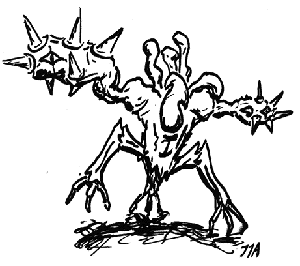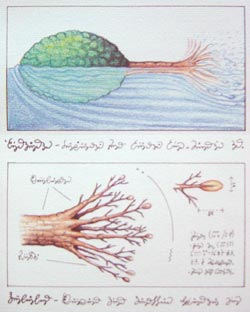 |
Introduction Site Map Email: jja@nac.net |

"I don't know. It is Odin's disk and it has only one side."
— J. L. Borges, The Disk.


Monday, August 2nd, 2004
I cheated myself this weekend and got little accomplished, creatively or otherwise. I did manage to redesign the site to support page archiving, but such modification is trivial and not to the point.
To conquer such slacking is the reason I started this site, and so I shall inexorably provide... watch for an update by Monday afternoon. In the meantime, you can revisit older entries via the directional arrows or the Site Map.
 Update:
Update:I've mentioned earlier that my aliens will be bipedal. (The critter to the left is tripedal; more about it in the next entry.) There are a host of assumptions behind this; the first is that the aliens use feet and legs to get around. (Alternatives that exist on Earth include flight, slithering, oozing (snails), burrowing and swimming.)
I'm also assuming that they get around, and are not rooted to one spot, which brings up the question: Would it be possible for a tree-like being to develop intelligence? I think not, because I see intelligence as developing in response to environmental challenges. If you're stuck in one place for your whole life, there's not much to which you can respond, and your experience and ability to change your environment are extremely limited.
 Even as I write
this, however, I can come up with
counterexamples. Suppose we have a tree-like being which contains
within itself a complex miniature ecosystem, perhaps itself inhabited
by intelligent life; might this count as an
environmental challenge? And plants on Earth are capable of movement of
stems and leaves, so is it too much of a stretch to imagine rooted
beings that can shift their position in the soil over time, and
thus move about (very slowly)? The surrealist artist Luigi
Serafini, in
his Codex
Seraphinianus (a massive encyclopedia of a bizarre alternate
history, full of enigmatic illustrations and written in an
undecipherable language), presents tree-like things (see image at
right) that can uproot
themselves and even migrate across the sea by using paddle-shaped roots
as flagellae... At this point, I've talked myself into exploring this
in the main project as at least a side issue. But this doesn't change
my intent for the Eaie (the primary race of aliens that I intend to
present) which I have imagined as bipedal.
Even as I write
this, however, I can come up with
counterexamples. Suppose we have a tree-like being which contains
within itself a complex miniature ecosystem, perhaps itself inhabited
by intelligent life; might this count as an
environmental challenge? And plants on Earth are capable of movement of
stems and leaves, so is it too much of a stretch to imagine rooted
beings that can shift their position in the soil over time, and
thus move about (very slowly)? The surrealist artist Luigi
Serafini, in
his Codex
Seraphinianus (a massive encyclopedia of a bizarre alternate
history, full of enigmatic illustrations and written in an
undecipherable language), presents tree-like things (see image at
right) that can uproot
themselves and even migrate across the sea by using paddle-shaped roots
as flagellae... At this point, I've talked myself into exploring this
in the main project as at least a side issue. But this doesn't change
my intent for the Eaie (the primary race of aliens that I intend to
present) which I have imagined as bipedal.As to why I assume that my aliens would even have feet and legs... That will be the topic for the next entry.



pageatatime.com is hosted by net access corporation - www.nac.net